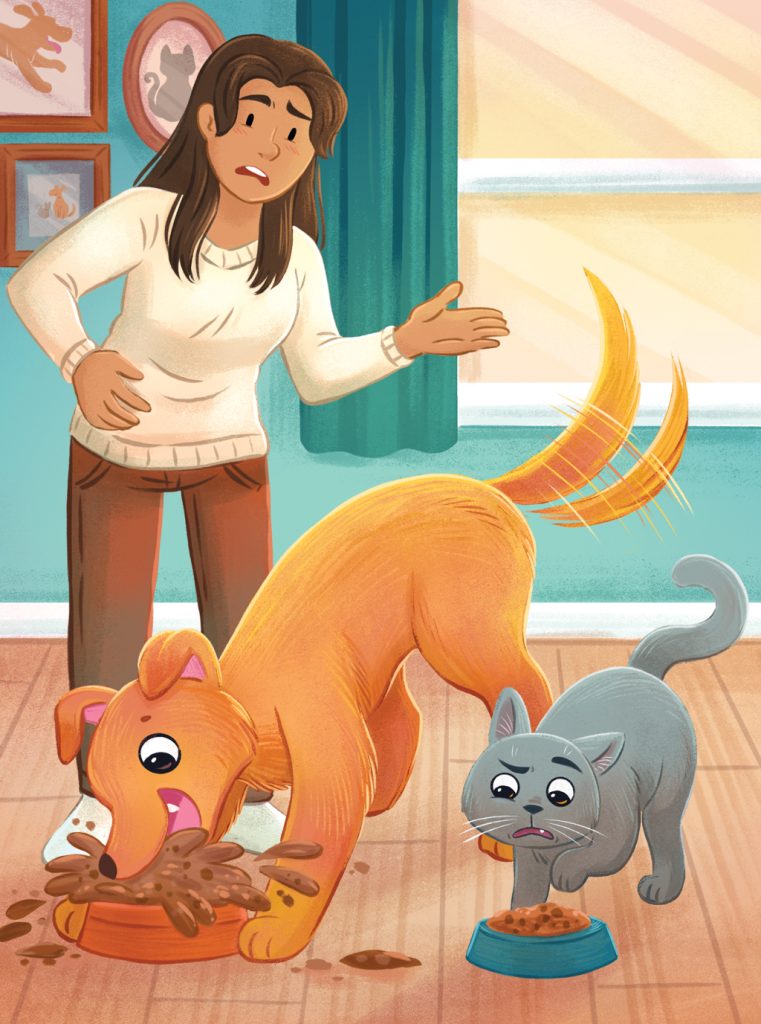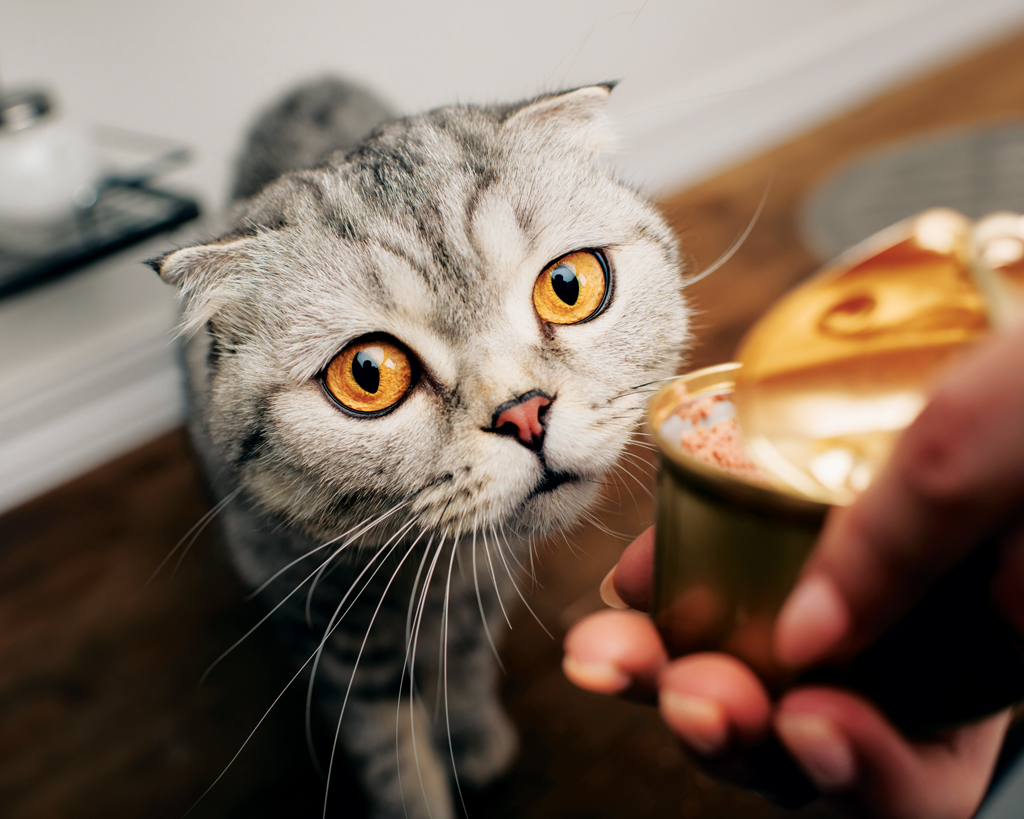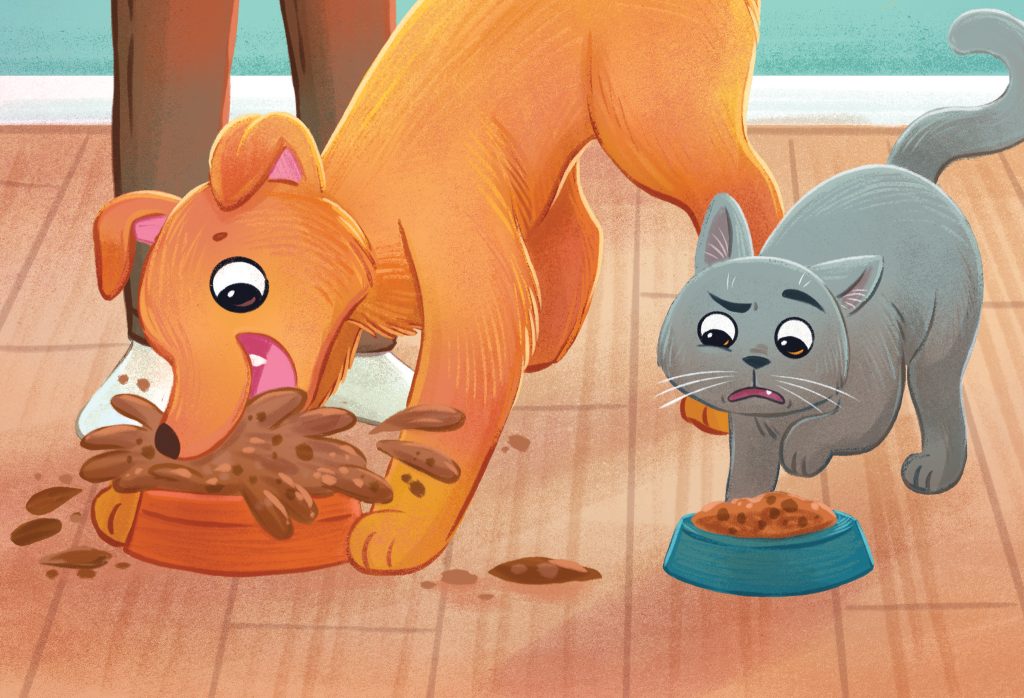Any pet owner who has ever watched their cat refuse to eat the priciest store-bought food—while their dog happily devours rocks, shoes, dirty socks, and nuggets unearthed from the litter box—has pondered the polar-opposite tastes of their feline and canine companions. What causes these differences in our furry friends?
Omnivores and Carnivores
From the smallest housecat to the largest tiger, all cats are obligate carnivores: they require meat for their survival and cannot properly digest plants. Meat makes up more than 70 percent of a cat’s diet, which means that cats also belong to a small group of creatures called hypercarnivores. (Other members of this exclusive group include owls, snakes, spiders, and most sharks.)
UK veterinary surgeon Daisy May points out that cats, as obligate carnivores, have very particular dietary needs. “They’re finely tuned to seek out high-protein, meat-based meals. Their fussiness often stems from this biological predisposition. A cat may turn its nose up at certain foods because it simply doesn’t meet their nutritional requirements,” she says. “So, in a way, their pickiness is a survival instinct, ensuring they get the nutrients they need to thrive.”
Domestic dogs, by contrast, are omnivores. Like humans, dogs can remain healthy eating everything from meat and plants to (some) fungi and algae. “Cats evolved to be more fastidious, specialized hunters, whereas dogs evolved more as opportunistic scavengers, giving them each different survival strategies around food,” explains Emma Fulton, a veterinarian in the UK. “Dogs are less discerning and more willing to eat whatever food sources are available to them. Their survival instincts drive them to take advantage of any potential meal, even if it’s rotten or unappealing to human sensibilities.” This drive to survive, she notes, can sometimes “override their good judgement and lead them to eat things that may cause gastrointestinal upset or even toxicity.”
“This all goes a long way toward explaining why an animal carcass washed up on a beach is unappetizing to a cat but may be pure ambrosia to a dog.”
For cats, freshly killed small prey such as rodents and birds are the ultimate in enticing fare. “This reliance on fresh meat likely made them more wary of spoiled foods,” Fulton says. “A key difference from cats is that dogs have evolved more robust digestive systems to handle eating spoiled or rotten foods. Their stomachs are quite acidic, with a pH close to 1, which helps destroy pathogenic microbes. Their short digestive tracts also move food through more quickly. So, while eating questionable foods is still risky, dogs are better equipped to consume things that would make cats and humans ill.” This all goes a long way toward explaining why an animal carcass washed up on a beach is unappetizing to a cat but may be pure ambrosia to a dog.

Illustration by Michelle Simpson
Taste Sensations
Also playing key roles in the differing preferences of cats and dogs are the taste sensations of bitterness, sweetness, and umami. “Cats have a much stronger sense of taste than dogs thanks to having more bitter taste receptors. Foods that taste bland or even pleasant to dogs and humans can taste quite bitter and unappealing to cats,” Fulton says. A study published in 2015 in the journal BMC Neuroscience compared the bitter receptors of domestic cats with those of humans and concluded that cats are much more sensitive to bitterness. Fulton notes that rotten or toxic foods can seem especially unappealing to cats, given their powerful sense of taste. Dogs, though, “are drawn to strong tastes like sweetness and umami, which signal calories and protein. Even foods that taste bitter to them may still be appealing if hungry enough.”
And, says Texas veterinarian Michael Thompson, who is an expert on animal nutrition, “Cats are shown to lack the taste receptors for sweetness that many animals, including dogs, possess.” Scientists examined the DNA of several healthy domestic cats, along with some tigers and cheetahs, analyzing the Tas1r2 and Tas1r3 genes that usually work together to allow sweetness to be detected. The study’s results, published in 2005 in the journal PLOS/Genetics, indicate that the Tas1r3 gene in cats works fine, but the Tas1r2 gene does not, causing cats to be unable to perceive sweetness. Thompson says, “This may make cats naturally picky since their flavour palette is limited.”
Cats don’t like bitterness and can’t taste sweetness, but they can’t get enough umami. Sometimes called savouriness, umami is the rich, meaty flavour characteristic of cheese, mushrooms, wine, broth, and cooked meats. Researchers studied umami taste perception in domestic cats, and their results, published in 2023 in the journal Chem Senses, show that umami is by far the strongest taste preference for cats.
Joshua Errett, founder of Noochies! Cultivated Pet Food in California, acknowledges how fussy cats are, saying, “They have the reputation for being very picky animals for a reason.” He also knows firsthand how powerful their desire for umami can be. Errett was at home, trying to create a dog treat out of a nutritional yeast blend, when his cats became extremely interested in the yeast. “They kept coming into my room,” he says. “I had it in a box, and they were trying to get in the box.” After he put some yeast powder in a bowl for them, his cats eagerly licked it up.
Cats have “almost a little laboratory in their noses and mouths and tongues,” Errett says. “They can sense what benefit the food has for them.” Dogs rely mainly on smell, but not cats: “It’s not all olfactory. Their tongues do a lot of the work.” They’re also very good at determining “what has that specific amino acid profile they like.” The umami of Noochies nutritional yeast is such a hit with cats and dogs alike that the company is making freeze-dried yeast treats for both.
Routines and Adventures
Cats are known for disliking change, while dogs are viewed as more adventurous. These tendencies can extend to food preferences. Cats, says Fulton, “take great comfort in familiarity and routine. An abrupt change in their diet can lead to finicky eating or refusal to eat the new food.”
Thompson agrees, saying, “Cats are creatures of habit, meaning they may reject unexpected changes if they are used to a particular food. Dogs, however, can be conditioned to eat various types of food due to their historical roles as scavengers.” Cats rely on familiarity and consistency to feel secure. “They develop daily habits around feeding, grooming, and playtime. Any disruption to their routine can cause stress and anxiety.”
Plus, Thompson says, “Cats have keen senses, especially their sense of smell and hearing. They can be highly sensitive to new scents, sounds, and environments. Unexpected changes may introduce unfamiliar scents or noises that can make them feel on edge.” As naturally risk-averse creatures, cats may see changes as possible threats. “Their instinct is to be cautious and avoid unfamiliar situations to protect themselves.”

LightField Studios/Shutterstock
Introducing New Foods
Any pet, whether a cat or a dog, might need some encouragement to try eating something new. “Dogs are generally more easygoing with their meals, and we often see them happily chow down on whatever’s in their bowl,” says Mark Sapir, Chief Marketing Officer of Open Farm. The Colorado company makes ethical, sustainable food for pets. “Cats, on the other hand, tend to be a bit more particular. They like sticking to what they know and are less adventurous. When it comes to wet food, they have specific texture and animal protein preferences, making it a bit challenging to introduce new foods. Once you find something they love, they’re usually hooked.”
Sapir shares some advice to follow when introducing new foods. “For dogs, it’s all about making the meal special. If your pup isn’t enthusiastic about their regular food, try topping it with something extra, like freeze-dried treats, wet food, or a savory broth. These additions can pique their interest and get those tails wagging,” he says. “Cats are a little trickier. Patience is key here. Take it slow and introduce new foods gradually. Discover the texture and protein they adore and stick with it.” He lists the company’s most popular flavours: chicken and beef for dogs, poultry and fish for cats. “That said, dogs are generally more open to variety and can enjoy rotating flavours.”
Daisy May, the UK veterinary surgeon, points out that some cats are actually quite adventurous eaters, while some dogs can be more hesitant. “We all know cats go crazy for meat, but some are totally down to try other foods too, especially if they’ve been exposed to a variety from a young age. And get this—cats can pick up habits from each other! If they see another feline or even a human family member munching on something, their curiosity might just get the best of them,” she says. “With dogs, a bad experience with a certain food can be a turn-off if it led to an upset stomach. Some pups are naturally more cautious and need time to warm up to new treats and textures.”
As always, the key to understanding any specific dog or cat is remembering that each one is an individual. May says, “The main thing is that each animal has their own unique personality and history that shapes their preferences.”
This article originally appeared in the award-winning Modern Cat magazine. Subscribe today!
